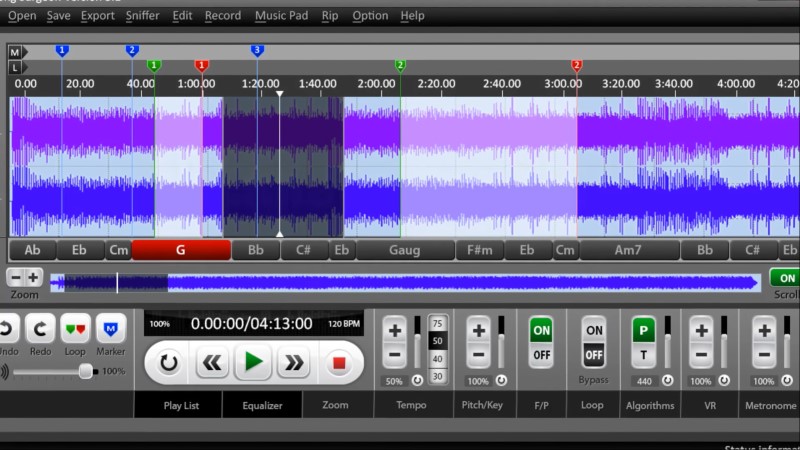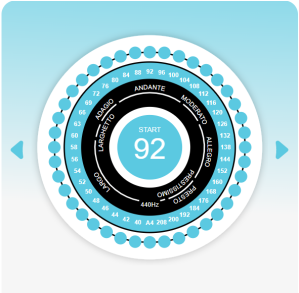Home
>
Lead
 Alternate
Picking Alternate picking simply
involves using down and up picking strokes
alternately. Not as easy as it sounds at first, so this lesson should
help you develop solid timing, a decent level of speed and confidence
in these
initial
stages. Also in this series...
Alternate
Picking Alternate picking simply
involves using down and up picking strokes
alternately. Not as easy as it sounds at first, so this lesson should
help you develop solid timing, a decent level of speed and confidence
in these
initial
stages. Also in this series...
 Timing
Impeccable timing is what separates the great guitarist from the
mediocre. This series offers a clear practice method for developing
your rhythm and timing, including note values, triplets, syncopation...
nail this early on, and your progress will soar. Also in this series...
Timing
Impeccable timing is what separates the great guitarist from the
mediocre. This series offers a clear practice method for developing
your rhythm and timing, including note values, triplets, syncopation...
nail this early on, and your progress will soar. Also in this series...
 Open
String Lead Video showing you some ideas for using
open strings in your lead playing.
Open
String Lead Video showing you some ideas for using
open strings in your lead playing.
 How
to Practice Scales Apply the timing elements from
the series above to scales. Focuses on speed and scale
navigation techniques to help
you get physically comfortable with moving around the fretboard. Also
in this series...
How
to Practice Scales Apply the timing elements from
the series above to scales. Focuses on speed and scale
navigation techniques to help
you get physically comfortable with moving around the fretboard. Also
in this series...
 Scale
Exercises A library of essential
exercises to improve your speed
and timing. This series covers the physical aspects of scale navigation
including runs, intervallic movements and string skipping.
Also in this series...
Scale
Exercises A library of essential
exercises to improve your speed
and timing. This series covers the physical aspects of scale navigation
including runs, intervallic movements and string skipping.
Also in this series...
 Double
Stops A lead technique that
involves playing two notes simultaneously. Starting with the basic
double stop fingerings and exercises and moving on to mixing them with
regular lead phrases from scales. See also:
Double
Stops A lead technique that
involves playing two notes simultaneously. Starting with the basic
double stop fingerings and exercises and moving on to mixing them with
regular lead phrases from scales. See also:
 String
Skipping
String skipping is pretty self
explanatory. The idea is
to "skip" over strings in your soloing phrases to create less linear
patterns with wider intervals. This lesson provides the basics and
explains how the technique is beneficial and how to pick licks
that use string skipping. Also in this series...
String
Skipping
String skipping is pretty self
explanatory. The idea is
to "skip" over strings in your soloing phrases to create less linear
patterns with wider intervals. This lesson provides the basics and
explains how the technique is beneficial and how to pick licks
that use string skipping. Also in this series...
 Pedal Point
Pedal pont is
a technique that involves alternating between a fixed or re-articulated
note and other notes. A great way to develop several core lead skills
in one go.
This lesson will get you up to speed with some basic exercises.
Pedal Point
Pedal pont is
a technique that involves alternating between a fixed or re-articulated
note and other notes. A great way to develop several core lead skills
in one go.
This lesson will get you up to speed with some basic exercises.
 String
Bending String bending really does
liven up boring, flat
solos, and every lead guitarist should be confident with using bends.
Learn to bend with ease and precision with this two
part series with video.
Part 1 introduces the physical basics, before we move on to more
specific
bending techniques in further parts (below).
String
Bending String bending really does
liven up boring, flat
solos, and every lead guitarist should be confident with using bends.
Learn to bend with ease and precision with this two
part series with video.
Part 1 introduces the physical basics, before we move on to more
specific
bending techniques in further parts (below).
 Vibrato
An essential technique for
punctuating your lead
phrases. On guitar, vibrato is applied using a form of repeating,
pulsing string
bend. This lesson (with video) shows you the basic technique, essential
exercises and some different ways of applying vibrato.
Vibrato
An essential technique for
punctuating your lead
phrases. On guitar, vibrato is applied using a form of repeating,
pulsing string
bend. This lesson (with video) shows you the basic technique, essential
exercises and some different ways of applying vibrato.
 Legato On
guitar, legato simply
refers to playing without
picking. This is acheived predominantly through the use of hammer ons
and pulls offs. In these lessons I'll introduce the basic hammer
on and pull off techniques, provide exercises to get all your fingers
involved and finally look at combining the two.
Legato On
guitar, legato simply
refers to playing without
picking. This is acheived predominantly through the use of hammer ons
and pulls offs. In these lessons I'll introduce the basic hammer
on and pull off techniques, provide exercises to get all your fingers
involved and finally look at combining the two.
 Sliding
Technique
Mastering slides will help you move smoothly and fluidly over the neck.
A very cool sounding, yet simple skill to master. We start
with the basics, getting physically comfortable with sliding between
frets, in to and out of notes. See also:
Sliding
Technique
Mastering slides will help you move smoothly and fluidly over the neck.
A very cool sounding, yet simple skill to master. We start
with the basics, getting physically comfortable with sliding between
frets, in to and out of notes. See also:
 Chromatic
Approach
A simple way of using hammer-ons, slides and bending to inject feeling
and emotion into your lead playing. Once you've learned those core
techniques above, this lesson will show you how to apply them to scales
and licks.
Chromatic
Approach
A simple way of using hammer-ons, slides and bending to inject feeling
and emotion into your lead playing. Once you've learned those core
techniques above, this lesson will show you how to apply them to scales
and licks.
 Arpeggio
Technique
Different ways you can physically play arpeggios, including alternate
picking, string skipping, rolling, legato, sweep picking and tapping.
Using the techniques in this lesson will help you play arpeggios faster.
Arpeggio
Technique
Different ways you can physically play arpeggios, including alternate
picking, string skipping, rolling, legato, sweep picking and tapping.
Using the techniques in this lesson will help you play arpeggios faster.
 Octave
Lead Explores Octaves and how to
incorporate them into your playing. If you've just learned your scales,
they are a great way to branch out from the "practicing scales" sound
to something more melodic. Octaves are also helpful to memorizing the
fretboard.
Octave
Lead Explores Octaves and how to
incorporate them into your playing. If you've just learned your scales,
they are a great way to branch out from the "practicing scales" sound
to something more melodic. Octaves are also helpful to memorizing the
fretboard.
 Finger
Tapping Get to grips with the physical
side of tapping and
your knowledge of scales will integrate naturally. If you follow both
lessons
below and take your time mastering various tapping rhythms and the
physical side
of it, it's actually not as difficult as it sounds!
Also in this series...
Finger
Tapping Get to grips with the physical
side of tapping and
your knowledge of scales will integrate naturally. If you follow both
lessons
below and take your time mastering various tapping rhythms and the
physical side
of it, it's actually not as difficult as it sounds!
Also in this series...
Lead Guitar Lessons - Improve Your Lead Technique
These clear and comprehensive lead guitar lessons will give you the skills and confidence you need to create those spine tingling solos we all love. Simply start at the top and work through the lessons in the order they're presented, following the path to becoming a more confident and dynamic lead player.

|
Skillful lead isn't about playing as fast as possible, although speed and timing are important soloing elements. Lead is primarily about personal expression, as though you're speaking through the guitar. Don't get too caught up in the notes-per-second race. Speed will come naturally.
The lead guitar techniques below can be seen as the physical application of notes and scales on the fretboard. So the two go hand in hand (see the scales section in the top menu).
The idea is to equip yourself with a number of ways of getting from one note to the next in your solo - bend, tap, string skip, hammer on, slide etc.Learn Lead Guitar Step by Step
Loosen up your fingers with these finger warm up exercises Alternate
Picking Alternate picking simply
involves using down and up picking strokes
alternately. Not as easy as it sounds at first, so this lesson should
help you develop solid timing, a decent level of speed and confidence
in these
initial
stages. Also in this series...
Alternate
Picking Alternate picking simply
involves using down and up picking strokes
alternately. Not as easy as it sounds at first, so this lesson should
help you develop solid timing, a decent level of speed and confidence
in these
initial
stages. Also in this series... Timing
Impeccable timing is what separates the great guitarist from the
mediocre. This series offers a clear practice method for developing
your rhythm and timing, including note values, triplets, syncopation...
nail this early on, and your progress will soar. Also in this series...
Timing
Impeccable timing is what separates the great guitarist from the
mediocre. This series offers a clear practice method for developing
your rhythm and timing, including note values, triplets, syncopation...
nail this early on, and your progress will soar. Also in this series... Open
String Lead Video showing you some ideas for using
open strings in your lead playing.
Open
String Lead Video showing you some ideas for using
open strings in your lead playing. How
to Practice Scales Apply the timing elements from
the series above to scales. Focuses on speed and scale
navigation techniques to help
you get physically comfortable with moving around the fretboard. Also
in this series...
How
to Practice Scales Apply the timing elements from
the series above to scales. Focuses on speed and scale
navigation techniques to help
you get physically comfortable with moving around the fretboard. Also
in this series...
 Scale
Exercises A library of essential
exercises to improve your speed
and timing. This series covers the physical aspects of scale navigation
including runs, intervallic movements and string skipping.
Also in this series...
Scale
Exercises A library of essential
exercises to improve your speed
and timing. This series covers the physical aspects of scale navigation
including runs, intervallic movements and string skipping.
Also in this series... Double
Stops A lead technique that
involves playing two notes simultaneously. Starting with the basic
double stop fingerings and exercises and moving on to mixing them with
regular lead phrases from scales. See also:
Double
Stops A lead technique that
involves playing two notes simultaneously. Starting with the basic
double stop fingerings and exercises and moving on to mixing them with
regular lead phrases from scales. See also: String
Skipping
String skipping is pretty self
explanatory. The idea is
to "skip" over strings in your soloing phrases to create less linear
patterns with wider intervals. This lesson provides the basics and
explains how the technique is beneficial and how to pick licks
that use string skipping. Also in this series...
String
Skipping
String skipping is pretty self
explanatory. The idea is
to "skip" over strings in your soloing phrases to create less linear
patterns with wider intervals. This lesson provides the basics and
explains how the technique is beneficial and how to pick licks
that use string skipping. Also in this series... Pedal Point
Pedal pont is
a technique that involves alternating between a fixed or re-articulated
note and other notes. A great way to develop several core lead skills
in one go.
This lesson will get you up to speed with some basic exercises.
Pedal Point
Pedal pont is
a technique that involves alternating between a fixed or re-articulated
note and other notes. A great way to develop several core lead skills
in one go.
This lesson will get you up to speed with some basic exercises. String
Bending String bending really does
liven up boring, flat
solos, and every lead guitarist should be confident with using bends.
Learn to bend with ease and precision with this two
part series with video.
Part 1 introduces the physical basics, before we move on to more
specific
bending techniques in further parts (below).
String
Bending String bending really does
liven up boring, flat
solos, and every lead guitarist should be confident with using bends.
Learn to bend with ease and precision with this two
part series with video.
Part 1 introduces the physical basics, before we move on to more
specific
bending techniques in further parts (below). Vibrato
An essential technique for
punctuating your lead
phrases. On guitar, vibrato is applied using a form of repeating,
pulsing string
bend. This lesson (with video) shows you the basic technique, essential
exercises and some different ways of applying vibrato.
Vibrato
An essential technique for
punctuating your lead
phrases. On guitar, vibrato is applied using a form of repeating,
pulsing string
bend. This lesson (with video) shows you the basic technique, essential
exercises and some different ways of applying vibrato. Legato On
guitar, legato simply
refers to playing without
picking. This is acheived predominantly through the use of hammer ons
and pulls offs. In these lessons I'll introduce the basic hammer
on and pull off techniques, provide exercises to get all your fingers
involved and finally look at combining the two.
Legato On
guitar, legato simply
refers to playing without
picking. This is acheived predominantly through the use of hammer ons
and pulls offs. In these lessons I'll introduce the basic hammer
on and pull off techniques, provide exercises to get all your fingers
involved and finally look at combining the two.
 Sliding
Technique
Mastering slides will help you move smoothly and fluidly over the neck.
A very cool sounding, yet simple skill to master. We start
with the basics, getting physically comfortable with sliding between
frets, in to and out of notes. See also:
Sliding
Technique
Mastering slides will help you move smoothly and fluidly over the neck.
A very cool sounding, yet simple skill to master. We start
with the basics, getting physically comfortable with sliding between
frets, in to and out of notes. See also: Chromatic
Approach
A simple way of using hammer-ons, slides and bending to inject feeling
and emotion into your lead playing. Once you've learned those core
techniques above, this lesson will show you how to apply them to scales
and licks.
Chromatic
Approach
A simple way of using hammer-ons, slides and bending to inject feeling
and emotion into your lead playing. Once you've learned those core
techniques above, this lesson will show you how to apply them to scales
and licks. Arpeggio
Technique
Different ways you can physically play arpeggios, including alternate
picking, string skipping, rolling, legato, sweep picking and tapping.
Using the techniques in this lesson will help you play arpeggios faster.
Arpeggio
Technique
Different ways you can physically play arpeggios, including alternate
picking, string skipping, rolling, legato, sweep picking and tapping.
Using the techniques in this lesson will help you play arpeggios faster. Octave
Lead Explores Octaves and how to
incorporate them into your playing. If you've just learned your scales,
they are a great way to branch out from the "practicing scales" sound
to something more melodic. Octaves are also helpful to memorizing the
fretboard.
Octave
Lead Explores Octaves and how to
incorporate them into your playing. If you've just learned your scales,
they are a great way to branch out from the "practicing scales" sound
to something more melodic. Octaves are also helpful to memorizing the
fretboard. Finger
Tapping Get to grips with the physical
side of tapping and
your knowledge of scales will integrate naturally. If you follow both
lessons
below and take your time mastering various tapping rhythms and the
physical side
of it, it's actually not as difficult as it sounds!
Also in this series...
Finger
Tapping Get to grips with the physical
side of tapping and
your knowledge of scales will integrate naturally. If you follow both
lessons
below and take your time mastering various tapping rhythms and the
physical side
of it, it's actually not as difficult as it sounds!
Also in this series...Essential Lead Guitar Tools
 |
Song Slow Down, Chord Detect, Key Change & MoreSong Surgeon allows you to import a sound file (e.g. mp3), slow it right down, cut out the vocals, hear it note-for-note and loop the part you want to learn. As well as changing tempo, you can also change the pitch of the audio to learn it in different keys and there's even automatic chord detection. Far more productive than learning purely by tab. Learn More About Song Surgeon Here Learn More About Song Surgeon Here |
 |
Online MetronomeMetronomes help you keep time during your practice, allowing you to speed up gradually (think increments of 5 BPM) as your confidence improves. I strongly recommend using a metronome for every lead technique you learn. Get into the habit now! This one's my favourite... Free
Online Metronome Free
Online Metronome |
Stay updated and learn more
Sign up to the newsletter for updates and grab your free Uncommon Chords book
Sign up to the newsletter for updates and grab your free Uncommon Chords book







